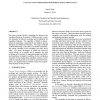1972 search results - page 9 / 395 » Hidden semi-Markov models |
MOBIHOC
2006
ACM
14 years 7 months ago
2006
ACM
Recent studies on mobility modeling have focused on characterizing user mobility from real traces of wireless LANs (WLANs) and creating mobility models based on such characterizat...
WSC
2008
13 years 9 months ago
2008
This paper presents PiDES, a formalism for discrete event simulation based on Pi-calculus. PiDES provides a rigorous semantics of behavior modeling and coordination for simulation...
ICPP
1999
IEEE
13 years 11 months ago
1999
IEEE
This paper extended a mathematical technique to model the behaviour of token-passing protocol in a star-coupled wavelength-division multiplexing (WDM) optical network for traffic ...
INFOCOM
2003
IEEE
14 years 19 days ago
2003
IEEE
Abstract— We investigate a widely popular Least-RecentlyUsed (LRU) cache replacement algorithm with semi-Markov modulated requests. Semi-Markov processes provide the flexibility...
TCOM
2008
13 years 7 months ago
2008
Abstract--Incremental-redundancy hybrid automatic repeatrequest (IR-HARQ) schemes are proposed in several wireless standards for increased throughput-efficiency and greater reliabi...

